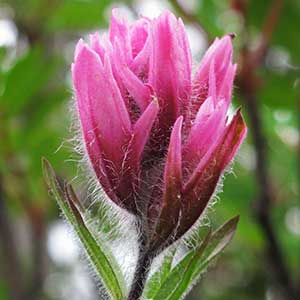Castilleja parviflora var. olympica
Castilleja parviflora var. parviflora
Olympic Indian paintbrush, Olympic Mountains paintbrush, Olympic paintbrush
small-flower Indian paintbrush, small-flower paintbrush
broadly lanceolate, rarely linear, margins plane, (0–)3(–5)-lobed, apex narrowly acute to acuminate;
lobes spreading, linear to lanceolate, lateral lobes nearly as long as terminal.
narrowly to broadly lanceolate or elliptic, margins plane, (3–)5–9-lobed, apex acute;
lobes spreading, linear.
distally pink-purple, magenta, deep rose, or crimson, rarely white, 3–7-lobed;
lobes lanceolate, arising near to above mid length.
distally magenta to pink-purple, sometimes pale orange, pink, or whitish, (3–)5(–7)-lobed;
lobes lanceolate-acuminate, arising near or above mid length.
12–20(–25) mm;
tube 8.5–19 mm;
beak exserted, (5.5–)7–9(–11) mm;
abaxial lip green;
teeth green.
12–20(–25) mm;
tube 10–12 mm;
beak exserted, 5.5–7 mm;
abaxial lip green;
teeth green.
deep purple with magenta or light pink lobes, 13–20(–28) mm;
abaxial clefts 6.5–12 mm, adaxial 7–15 mm, lateral 2–8 mm, 10–35% of calyx length;
lobes narrowly triangular, apex acute to obtuse.
colored as bracts, 12–17(–20) mm;
abaxial and adaxial clefts 6–11 mm, lateral 2–6 mm, 20–35% of calyx length;
lobes narrowly triangular, apex acute.
Castilleja parviflora var. olympica
Castilleja parviflora var. parviflora
Variety olympica is essentially endemic to the upper elevations of the Olympic Mountains, in northwestern Washington, though a handful of collections from high elevations on Vancouver Island, British Columbia, are also referable to this form.
(Discussion copyrighted by Flora of North America; reprinted with permission.)
Variety parviflora has relatively long hairs, many-lobed leaves, and a short corolla. Compared to the other varieties, it has a more boreal range, extending north to extreme southeastern Alaska and the Kluane Lake region of extreme southwestern Yukon. Specimens from northern and central British Columbia belong to this variety, but its precise southern limits and potential overlap with var. albida in southern British Columbia are still incompletely known. Plants presumably assignable to var. parviflora are also found in the Canadian Rocky Mountains in the vicinity of Banff and Jasper National parks, but they were until recently rarely collected and deserve further study.
(Discussion copyrighted by Flora of North America; reprinted with permission.)


